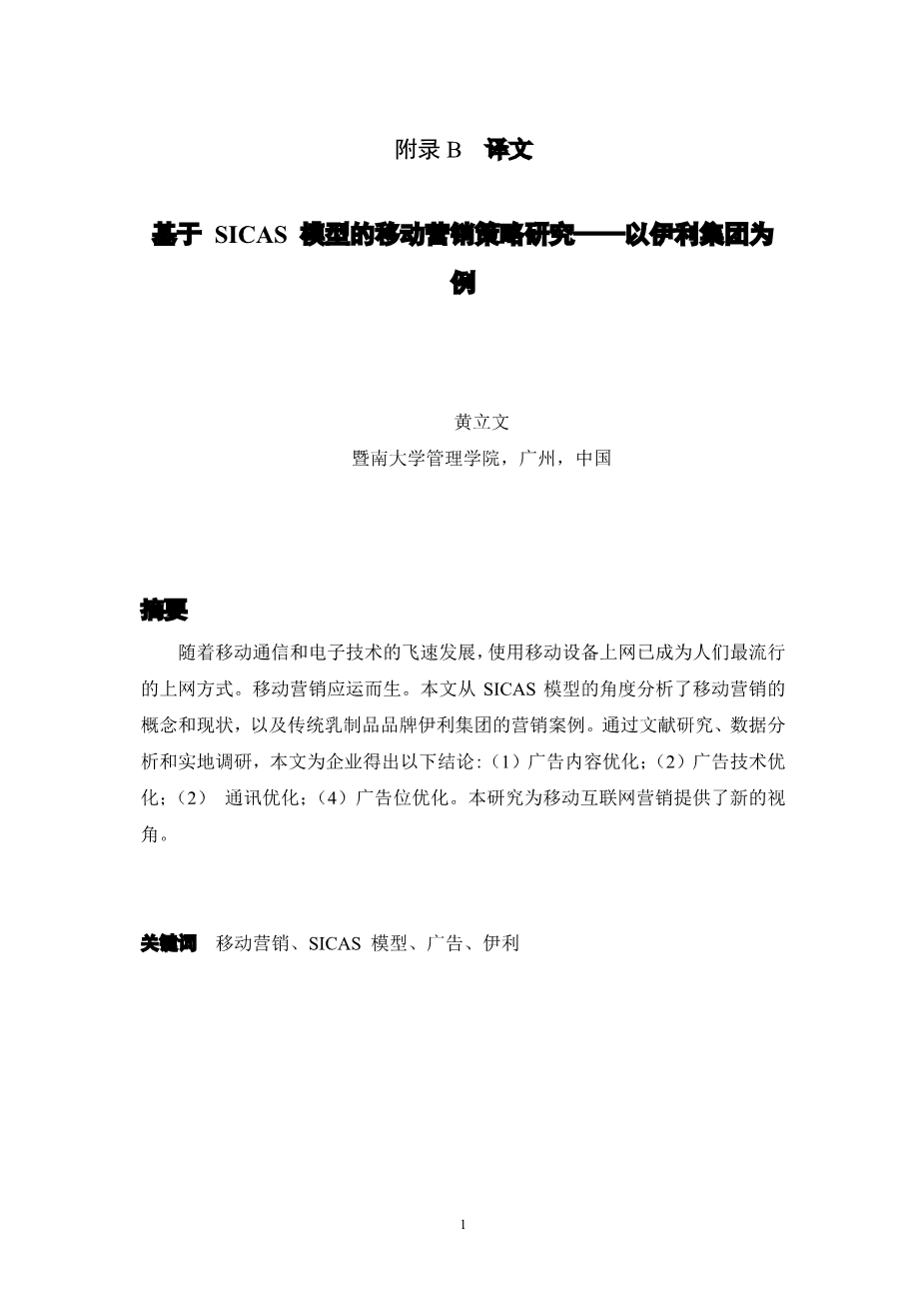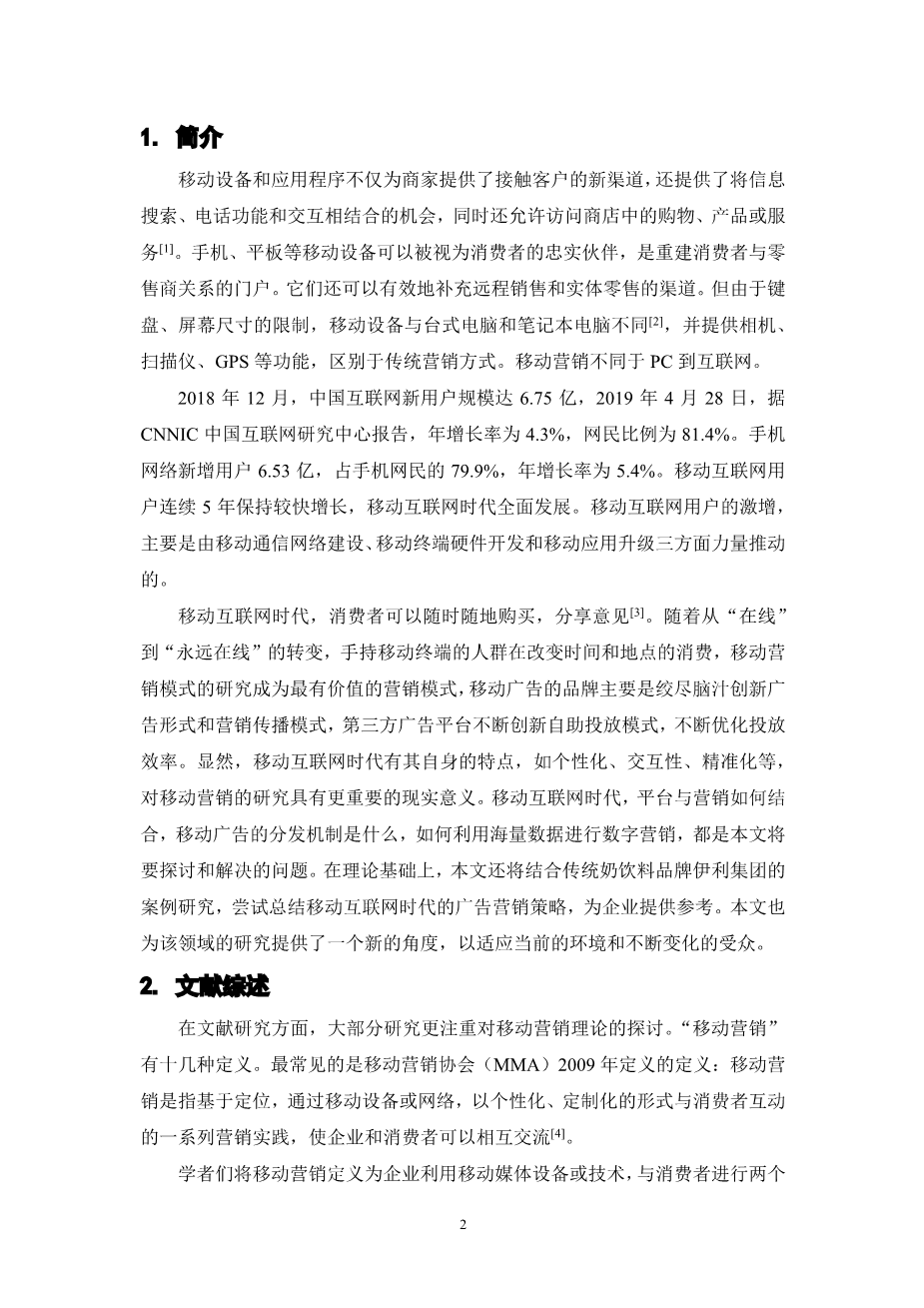附录C 外文原文
Research on Mobile Marketing Strategy Based on SICAS Model—A Case Study of Yili Group
Liwen Huang
School of Management, Jinan University, Guangzhou, China
Abstract
With the rapid development of mobile communication and electronic technology, the Internet with mobile device has become the most popular way for people to access. Mobile marketing came into being with a distinctive mark. From the perspective of SICAS model, this paper analyzed the concept and status of mobile marketing, and the marketing case of traditional dairy products brand Yili group. Based on literature research, data analysis and field research, this paper comes to the following conclusions for the enterprises: 1) Ad content optimization; 2) Ad technology optimization; 3) Communication optimization; 4) Ad placement optimization. This study provides a new perspective on the marketing of mobile Internet.
Keywords: Mobile Marketing, SICAS Model, Advertisement, Yili
1. Introduction
Mobile devices and apps not only provide merchants with new channels to reach customers, but also provide the opportunity to combine information search, phone functions and interaction, while also allowing access to shopping, products or services in the store [1]. Mobile devices such as mobile phones and tablets can be regarded as loyal partners of consumers and the gateway to rebuild the relationship between consumers and retailers. They can also effectively supplement the channels for remote sales and physical retail. But due to the limited keyboard, screen size, mobile devices and desktop computers and laptops are different [2], and provide functions such as cameras, scanners, and GPS, which makes different from traditional marketing. Mobile marketing is different from the PC to the Internet.
In Dec. 2018, Chinarsquo;s Internet new users have reached 675 million, with an annual growth rate of 4.3 percent, and the proportion of Internet users is 81.4 percent, as CNNIC China Internet research center reported. The mobile phone network new users 653 million, accounts for 79.9% of mobile Internet users, annual growth rate of 5.4%. Mobile internet users maintain faster growth for 5 years, the mobile internet era is in full development. A surge of mobile Internet users, is mainly driven by three forces—mobile communication network construction, the mobile terminal hardware development and the upgrading of mobile applications.
In the mobile internet era, consumers can purchase anytime and anywhere, as well as share their opinions [3]. With the transformation from “on-line” to “always online”, the crowd of handheld mobile terminals in changing consumption of time and place, and the research on the mobile marketing model has become the most valuable marketing model, the brand of mobile advertising mainly racks their brains to innovative forms of advertising and marketing communication mode, the third-party advertising platform constantly innovates self-service delivery mode, and continuously optimizes delivery efficiency. Obviously, the era of mobile Internet has its own characteristics, such as personalization, interaction and precision, etc., and the research on mobile marketing has more important practical significance. In the era of mobile Internet, how to combine platform with marketing, what is the distribution mechanism of mobile advertising, and how to use a large amount of data for digital marketing are all problems that this paper will discuss and solve. On the theoretical basis, this paper will also combine the case study of Yili Group, a traditional milk and beverage brand, to try to summarize the advertising and marketing strategies in the mobile Internet era, so as to provide reference for enterprises. This paper also provides a new angle for research in this field to adapt to the current environment and changing audience.
2. Literature Review
In terms of literature research, most of researches pay more attention to the discussion of the theory of mobile marketing. There are more than a dozen definitions of “mobile marketing”. The most common is the definition defined by the Mobile Marketing Association (MMA) in 2009: mobile marketing refers to a series of marketing practices based on positioning, carried out through mobile devices or networks, and through the form of personalized and customized interaction with consumers, so that enterprises and consumers can communicate with each other [4].
Scholars defined that mobile marketing as a marketing activity in which enterprises use mobile media devices or technologies to communicate with consumers in two or more directions and promote their products. This definition has also gained more recognition [5]. It can be seen that, for mobile marketing, there are several characteristics can be determined: (1)needy for mobile server and internet; (2)two-way communication and interaction with consumers; (3) consumer personality; (4)attain to reach a single consumer.
In the literature on mobile marketing, American media theorist Paul Levinson has explored the advantages and disadvantages and development prospects of mobile media from the perspective of media research in his works. He points out in the book that its humanization and intellectualization surpass any medium in human history, and calls the mobile phone as the “fifth medium” that surpasses the Internet, showing the strong development potential of mobile media to people [6]. The American scholar Cindy Krum in his 2010 book [7] depicted that panoramic scene in the United States the development of Mobile Internet Marketing, and he detailed lists and Mobile Internet advertising and Marketing is closely related to the technical details including media statistics, provides the domestic scholars on the Mobile Internet advertising and Marketing of the path of the overall i
剩余内容已隐藏,支付完成后下载完整资料
英语译文共 16 页,剩余内容已隐藏,支付完成后下载完整资料
资料编号:[588982],资料为PDF文档或Word文档,PDF文档可免费转换为Word
课题毕业论文、文献综述、任务书、外文翻译、程序设计、图纸设计等资料可联系客服协助查找。




